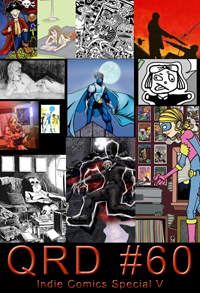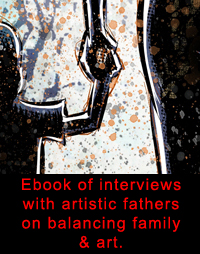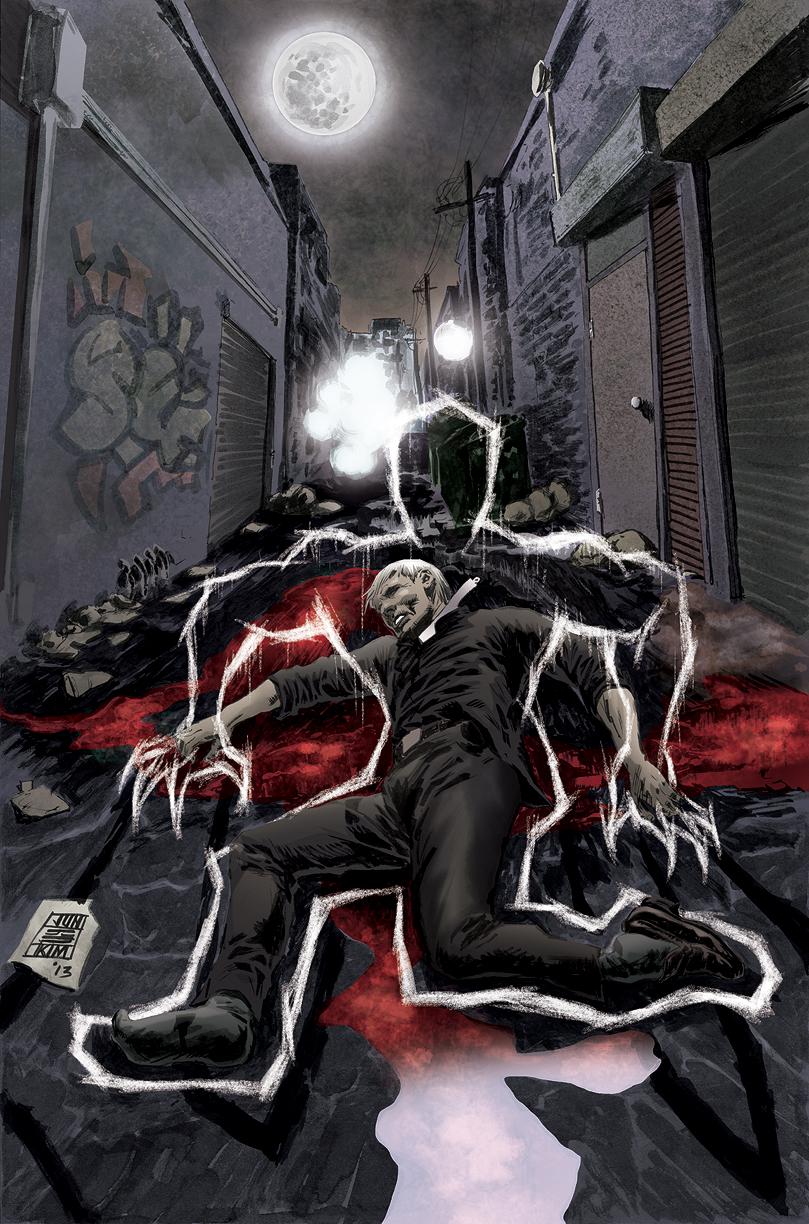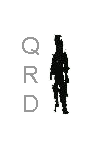
 |
| about
this issue Indie Comic Creator Interviews: Mike Dawson Floyd Lewis A.P. Fuchs Darin Shuler Trevor Denham Jules Rivera John Steventon Lorenzo Ross John Allison Michael San Giacomo Matt Chic Jackie Crofts Don W. Seven Derek Baxter Interview Series Updates: Nate McDonough Jason Dube Brian John Mitchell |
 |
 |
 |
 |
 |
 |
|
|
        |
April 2013

City: Cleveland, OH
Comics: Phantom Jack (Image), Tales of the Starlight Drive-In (Image), Phantom Jack: The Nowhere Man Agenda (IDW), & Chalk (publisher to be determined)
Websites: www.talesofthestarlightdrivein.com, www.cleveland.com/comic-books
QRD – How old were you when you first got into comics & did you always stick with them or did you come back to them?
Michael – I started reading my older brother’s comics way before kindergarten. I used to look at the pictures before I could read & learned to read using them by the age of 5. I never stopped.
QRD – What was the first comic book you ever bought?
Michael – The first comic I remember buying was Superboy No. 68, the first appearance of Bizarro. It was at a local grocery store in 1958 & cost a dime. I was six.
QRD – How old were you when you put out your first comic?
Michael – I put out my first comic (Phantom Jack) when I was in my late 40s after more than 25 years of writing about comics for newspapers, magazines, & websites.
QRD – What decade do you think produced the best comics?
Michael – That’s an easy one, the 1960s. You can’t deny that Stan & Jack changed everything & DC eventually followed.
QRD – Why comics instead of just writing or drawing?
Michael – Actually I do both. I’m a reporter for The Plain Dealer newspaper in Superman’s hometown of Cleveland. I write all the time. I’m the worst artist in the world & would never attempt to draw.
QRD – Do you see mini-comics & indie comics as paths to mainstream comics or as their own unique media?
Michael – I see them as both. They can be a unique media on their own. I’ve seen some amazing ones & some that are pretty awful, but they are a learning tool at the very least. Sometimes they can be a path to the mainstream comic media, as Brian Bendis can attest. But, it’s not a guarantee by any means. It’s very difficult swimming upstream to the DC or Marvel pool & there isn’t really any good way to get there. They are the best looking girls at the dance & everyone wants them. You have to figure out a way to get them to come to you. & when you do, let me know.
QRD – How many copies of your comic did you print in your first run?
Michael – I believe the first run of the Phantom Jack from Image was going around
10,000 books.
QRD – How much do you think comics should cost?
Michael – I think the going price of $2.99 to $3.99 is a fair price. It’s easier when you’re a Marvel or DC & you’re putting out strong books that can support the weaker ones. With an independent publisher, you sometimes have to sell a book for a higher price, like five bucks, so you can pay the printer, the artist, & all the people involved.
QRD – How many books do you produce a year & how many would you like to?
Michael – I produce perhaps one book every one or two years. It’s very slow because of the costs involved paying artists. The more popular artists are busy & there’s no way for small time writers to compete with DC or Marvel rates. I’d like to release a book every month or two, if I were able to hook up with a major company that would take over the arduous task of handling the art & production & just let me write.
QRD – Do you think stories should be serialized or delivered as complete works?
Michael – This is sort of a Sophie’s Choice question that comes from a false premise. You don’t have to choose. You can do both. Comics can be bought every month or, if someone has the patience, can be picked up as a trade paperback. While I prefer reading a whole trade, I lack the patience to wait & pick up the books I like every month.
QRD – How are comic strips different than comic books & which medium do you prefer?
Michael – Strips are definitely a medium under themselves. It’s damn hard to tell a story in three or four panels. I read ‘em every day.
QRD – How long is it from when you start a comic until it’s printed?
Michael – Personally it’s been as long as three or even four years from start to finish. My latest book, Chalk, started in 2003 & it took until 2013 to get together. Even now, with the book completely drawn, I have to find a publisher. So it could be yet another year.
QRD – What do you do better with your comics now than when you first started?
Michael – I think now that I have a few books behind me I have a better understanding of story flow. I’ve realized the importance of inserting clues early in a story that foreshadow coming events & gives the sharp readers a little thrill when they catch the nuances.
QRD – Do you do thumbnails?
Michael – Yes I do sometimes draw thumbnails, much to the chagrin of my artists because they’re pretty primitive. My thumbnails that is, not the artists.
QRD – At what size do you draw?
Michael – I take a regular page 8 x 10 sheet of paper & divided up like a comic book page.
QRD – What kind of pens do you use?
Michael – Nothing fancy, any pen will do.
QRD – What does your workstation look like?
Michael – I have a very cool workstation in my house. My writing desk is surrounded by music: cassettes, CDs, vinyl, & even hundreds of eight-tracks. I popped in the eight-tracks when I was writing Starlight Drive-In to get that period feeling. Gotta love that buzz & click.
QRD – At what point in the artistic process do you work digitally?
Michael – I’ll let my artists answer that part because I’m such a luddite.
QRD – What do you think of digital comics & webcomics?
Michael – I enjoy digital comics, but prefer real comics because I’m old-fashioned. I need to hold a comic in my hands to appreciate it.
QRD – Do you prefer working in color or black & white?
Michael – I prefer color, although my latest book, Chalk, is going to be in black-&-white because, well, it just needed to be in black-&-white.
QRD – How many different people should work on a comic & what should their jobs be?
Michael – Well that’s pretty easy, you need a writer, penciller, inker, colorist, letterer & editor. These days you need someone to help you digitize the work & get it out there.
QRD – How do you find collaborators?
Michael – I try to use the same people over & over because they’re good & reliable. Artist & technical director Sean McArdle is basically a genius & has saved my ass many times. Artist Dexter Wee can turn around a page faster than anyone I know. I’m lucky enough to know some fine artists & can usually find whomever I need through word-of-mouth.
QRD – How tight do you think a script should be as far as telling the artist what to draw?
Michael – I think it’s important for a writer to trust his artist to interpret his vision. I give my artists a lot of leeway & always write descriptive panel-by-panel scripts as say “here’s how I would do it, but if you can think of a better way final means try your way.” Nine times out of ten, I prefer their way.
QRD – What comic book person would you be most flattered to be compared to?
Michael – I’d be extremely flattered if anybody compared my work to anything by Alan Moore, Geoff Johns, or Brian Bendis (who I used to buy comics from when he worked at a shop in Cleveland).
QRD – What do your friends & family think of your comics?
Michael – My family & friends enjoy my work, at least they say they do. I always use their names as characters, which is an incentive for them to enjoy the work. They seem to particularly enjoy the text pieces that I have in almost every book.
QRD – What do you think of superheroes?
Michael – I have taught a course at Case Western Reserve University about superheroes & comics for six years, so obviously I enjoy superhero comics. Like ancient myths, they show us the human drama expanded to its extreme.
QRD – Marvel or DC?
Michael – Both. Both have great books & a few sucky ones. Buy what you like, regardless of popularity & whether they will increase in value. Assume they won’t & enjoy them.
QRD – What comic characters other than your own would you like to work with?
Michael – Believe it or not, my dream book would be Hank Pym of The Avengers. This character has gone through so many incarnations from Ant-Man to Giant-Man to Yellowjacket & has proven himself to be a little bit crazy. I’d love to get my hands on him.
QRD – Ideally would you self-publish?
Michael – The problem with self-publishing is promotion. It’s great to have complete control over a comic, but it’s a little pointless if no one ever sees it.
QRD – What conventions do you try to attend & why?
Michael – I go to shows all over the place. I’ve been to San Diego many times, Toronto has a particularly great show & I love going to Philadelphia because I’m originally from that area.
QRD – What do you do to promote your books?
Michael – I found the best way to promote books is to talk about them. I try to be interviewed in newspapers, magazines, television, & websites. It’s a challenge because there’s only a limited amount of time you can spend promoting, so I do everything I can to try to spread the word. I have never turned down an interview with anybody & have been pretty successful. I’ve been interviewed by, not just one, but two puppets.
QRD – Do you think your comics are well suited to comic shops or would sell better elsewhere?
Michael – Again I think both are the way to go. I’d love to see my books in comic shops as well as Barnes & Noble’s.
QRD – What other medium would you like to see some of your comics made into (television, film, games, action figures, etc.)?
Michael – I’ve always felt Tales of the Starlight Drive-In would make an amazing HBO or AMC 13-episode series. The beauty is in its very simplicity: A series of related stories set in a drive-in theater over a 50-year-period. It has an ending guaranteed to make you cry.
QRD – Do you consider yourself a comic collector or a comic reader or both?
Michael – I am both the collector & reader & have been most of my life
QRD – What do you see as the most viable mediums for comics distribution 10 years from now?
Michael – Ten years seems like an eternity, but I do agree with the obvious conclusion that there will be a lot more emphasis on digital comics &, sadly, less emphasis on comic book shops. I think that’s terrible because I value my weekly visits to the shop.
QRD – What would you like to see more people doing with comics?
Michael – I would like to see more people reading comics with a greater amount of respect. It bothers me that with these great movies like The Avengers & Batman, movies function with little recognition of the comics that started it all. Would it be so hard to include a promo with each film saying, “If you enjoy this movie check out the comics it came from such as...” & why not sell comics in the snack bar for those shows in association with a local comic shop?
